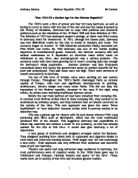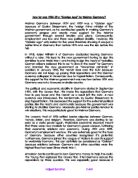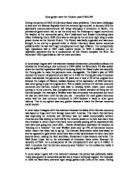If however Germany was in such a great economic state in this period, why is it that the Depression of 1929 could have a such a profound effect? The only explanations could be that there were already major flaws in the economy which, on the surface seemed to be extremely healthy, was not actually so. The first and most important factor is the American intervention through its loans. Accepting these loans seemed a more viable option than having to increase domestic taxation as would have been required in order to keep up with reparation payments, however the level of vulnerability that this would put Germany under was unanticipated. Short term loans financed long term projects under the assumption that loans could later be renewed. This was of course not the case and Germany was shown to be entirely reliant on not having any major fluctuations on Wall Street.
There were other flaws with the economy also. For example, increased production did not automatically mean greater foreign demand and so consumer demand would have to come from Germans itself. As it happened, between 1928 and 1929, production rose by 2% only for demand to fall by 3%. Thus, the rapid increase in industrial capacity could not be fully utilized.
The fact that there were fewer strikes did not mean that there was greater industrial harmony, simply that strike days had been kept down through government intervention and the actual wage increases only served to keep up with the rising cost of living.
There was split opinion over where any increasing profits should be spent with socialists feeling that wages should be increased and industrialists arguing for more investment in already saturated markets.
Unemployment was never really addressed also. Slight falls took place between 1926 and 1927 after which point it continued to rise.
The agriculture sector saw nothing of the prosperity being experienced elsewhere. Increased competition from overseas producers who had been more rapid in accepting modernization practices resulted in lower prices and the benefits of greater efficiency were never felt by German farmers who actually saw decreasing agricultural prices.
Between 1924 and 1929, the political system also appears to have been stable. In previous years we had seen the Spartacist uprising, the Kapp Putsch, and the Munich Putsch as well as many political assassinations. However, during this period there were no such events. Parties in opposition to the Republic were in the decline on both the left and right. Between the 1924 and 1928 elections for example, the extremist KPD party saw a decrease in its number of seats, as well as the DNVP and the Nazis also. At the same time, all the parties expected to support the republic were increasing their representation. Towards the end of the period, we also saw the re-union of a coalition between the SPD, Centre, DDP and DVP.
The statistics for the increases in seats for parties supporting the republic fail to show the tensions which were building up and surfaced after 1929. They also do not show the greater cohesion to the right, the main threat to the Republic. There were six Weimar governments between 1924 and 1929, each with a short-lived coalition and some without a secure majority in the Reichstag. These had been the product of the Proportional representation system. The politicians from different parties found it very difficult to co-operate. All preferred to stick to their principles rather than accepting the compromises required for effective government. Even those who tried to work together were unable to do so due to the constant bargaining required to stay in power.
Proportional Representation had meant that it was far too easy to obtain a seat in government and many parties had single seats. Nobody believed that the government could therefore do an effective job and, with its lack of charismatic leaders, found it very difficult to appeal.
A lot of the time, Weimar was seen as the lesser of two evils. The elite only supported Weimar as it was so against Communism, industrialists were unhappy as they were having many restrictions forced upon them such as minimum wages and less hours, landowners were unhappy at decreasing prices and their decreasing influence and the army had similar grievances in that they were given far less power also.
There was great realignment in the power and outlooks of the right wing parties during this period. The NSDAP and DNVP both carried out radical overhauls of themselves making them far more appealing to voters, the Nazis were slowly gaining respectability and all three spoke out against Stressemann’s policies regarding foreign relations through which, the signing of The Locarno Pact, The Treaty of Berlin, the joining of the League Of Nations and the acceptance of both the Young and Dawes Plan had been seen as Germany selling out. Germans resented the fact that they were now accepting responsibility for starting the war, agreeing to pay reparations, abiding by the borders imposed on them by the Treaty of Versailles and simply settling into a group of nations (League of Nations) who many Germans bitterly despised. For this reason, popularity of the government was always on the decline.
Finally, Hindenburg’s appointment was very detrimental to the democratic process also. He was always against this system and showed that he would not hesitate in taking advantage of article 48 when needed. This cloud of article 48 always hanging over the government did not help to create stability in Germany. The Reichstag always felt under threat.
Both the economic and political situation in Germany between 1924 and 1929 seem, on the surface to be very stable and possibly veering to what can be referred to as a ‘Golden Age.’ However, both had fundamental flaws which became apparent immediately after the end of this period. For example, the prosperity seen by some Germans was always very fragile due to its reliance on foreign success, primarily USA. Even whilst this so called ‘golden age’ was around, the agricultural industry was suffering badly and consumer demand was not high enough to take advantage of the increased efficiency in industry.
Politically, support for the Weimar Republic seems to have merely been a rejection of Communism rather than support for Weimar, and support decreased continually with every agreement giving in to foreign nations, made by Stressemann. The right wing extremist parties were gradually building support and it can now be seen that the fault lines were apparent during this period which were later to cause collapse and the depression of 1929. Therefore I don’t think it would be correct to refer to this as a ‘Golden Age’ although there were significant improvements when compared to the period immediately preceding this one.
By Amandeep Bindra







